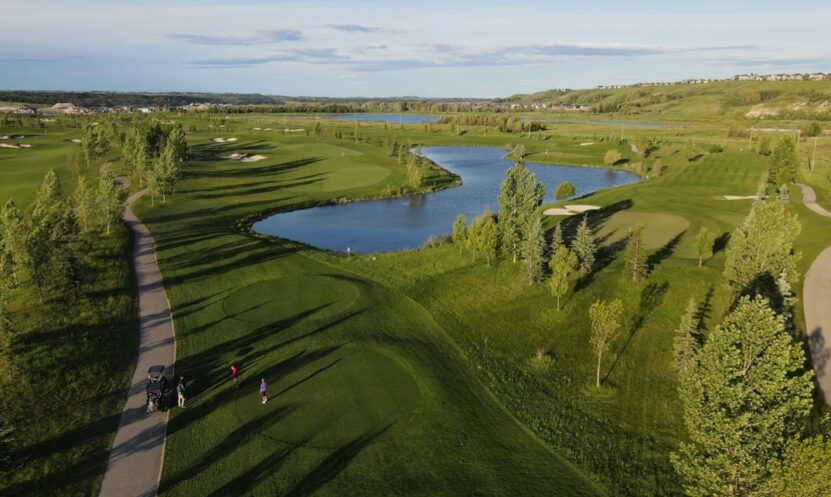How Many Acres Is A Golf Course?
A golf course typically spans several acres, usually ranging between 100-200 acres. Golf courses are expansive spaces designed for the game, with a varying number of holes and features such as fairways, greens, and water hazards.
These courses provide ample space for golfers to enjoy the sport while also incorporating natural elements like trees and landscapes. The acres dedicated to a golf course can vary depending on the specific layout and design, as well as local regulations and available land.
Factors Affecting Golf Course Size
When it comes to the size of a golf course, several factors come into play. Course design and layout, the number of holes, the type of golf course, and the presence of additional amenities and facilities are key determinants of the overall acreage. Let’s take a closer look at each of these factors:
Course Design and Layout
The design and layout of a golf course greatly impact its size. Golf courses are carefully crafted to provide a challenging and enjoyable playing experience for golfers of all levels. The layout includes factors such as the arrangement of the fairways, greens, tees, and hazards. Courses with strategic bunkering, water features, and undulating terrain require more acreage to accommodate these elements.
Number of Holes
The number of holes on a golf course is another crucial factor in determining its size. Traditional golf courses typically consist of 18 holes, while some may have as few as 9 holes. The average acreage required per hole is about 1.5 to 2.5 acres, although this can vary depending on other factors such as the course design and additional amenities.
Golf Course Type (Championship, Executive, or Pitch & Putt)
The type of golf course also influences its size. Championship golf courses, designed for professional tournaments, often require more acreage to accommodate longer fairways and challenging layouts. Executive courses, on the other hand, are smaller in size and cater to shorter games. Pitch & putt courses, designed for recreational play, are usually the smallest in terms of acreage.
Additional Amenities and Facilities
In addition to the golf course itself, the presence of additional amenities and facilities can increase the overall acreage. These may include clubhouse buildings, pro shops, practice facilities, driving ranges, putting greens, and maintenance areas. The size and number of these amenities can vary depending on the course’s intended target audience and level of luxury.
Overall, the size of a golf course is influenced by a combination of these factors. Course design, the number of holes, the type of course, and the presence of additional amenities all play a significant role in determining how many acres a golf course occupies.
Average Golf Course Sizes Around The World
Golf courses come in various sizes depending on their location and available land. The size of a golf course is typically measured in acres, and it can vary significantly from one country to another. In this article, we will explore the average golf course sizes in North America, Europe, and Asia, providing insight into the vast differences in golf course sizes worldwide.
North American Golf Course Size
United States
In the United States, golf courses are known for their sprawling landscapes and grandeur. The average size of a golf course in the US usually ranges between 100 and 200 acres. However, there are exceptional courses that cover much larger areas, often exceeding 300 acres.
Canada
Canada is home to a significant number of well-designed golf courses, and their sizes are comparable to those in the United States. Canadian golf courses typically vary between 100 and 200 acres, providing ample space for golfers to enjoy the game amidst the beautiful Canadian landscapes.
European Golf Course Size
United Kingdom
Golf courses in the United Kingdom tend to be smaller compared to their North American counterparts. The average golf course size in the UK generally ranges from 50 to 150 acres. These compact courses are beautifully designed to make the most efficient use of the available land while still offering challenging and enjoyable gameplay.
Germany
In Germany, golf courses are spread across the scenic countryside, and they often possess a peaceful aura. The average golf course size in Germany is typically around 100 acres, with some courses going up to 150 acres. These courses embrace nature and offer an incredible golfing experience amidst picturesque landscapes.
Asian Golf Course Size
Japan
Japan is renowned for its attention to detail and precision, and its golf courses reflect this commitment. Golf courses in Japan, on average, range from 50 to 150 acres, similar to the sizes found in the United Kingdom. These courses are meticulously maintained, combining elegance and precision to create a unique golfing experience.
South Korea
With a thriving golfing culture, South Korea boasts some fantastic golf courses. The average golf course size in South Korea is around 100 to 200 acres, providing ample space for golfers to enjoy the game and embrace the breathtaking natural scenery that the country has to offer.
Environmental Impact And Considerations
When it comes to golf courses, it’s essential to consider their environmental impact and how they affect the surrounding ecosystem. Golf courses cover vast amounts of land, with the size varying depending on the course’s design and layout. Let’s explore the specific environmental considerations related to land usage, water consumption, wildlife conservation efforts, and sustainable practices in golf course management.
Land Usage and Water Consumption
Golf courses require large acreage to accommodate fairways, greens, tees, and other playing areas. On average, an 18-hole golf course spans around 125-150 acres. However, high-end courses or those hosting professional tournaments may cover over 200 acres.
With the land being a valuable resource, golf courses must use it efficiently. Many courses employ sustainable land management practices, including:
- Reclaiming and repurposing unused areas for natural habitats or green spaces
- Implementing water-efficient irrigation systems to reduce water consumption
- Applying precision turf management techniques to optimize grass growth
By adopting these practices, golf courses can minimize their land usage while maintaining playable conditions for golfers.
Water consumption is another significant concern in golf course management. Maintaining lush, green fairways and greens requires irrigation, and courses must balance this need with responsible water usage. Golf courses employ various strategies to minimize water consumption, such as:
- Using drought-tolerant grass species that require less water
- Implementing smart irrigation systems to deliver water precisely where and when needed
- Collecting and reusing rainwater for irrigation purposes
Through these measures, golf courses can reduce their environmental impact and conserve precious water resources.
Wildlife Conservation Efforts
Golf courses often coexist with a diverse range of wildlife, including birds, mammals, and reptiles. Recognizing the importance of preserving and protecting these species, golf courses implement wildlife conservation efforts. Some key initiatives include:
- Creating designated wildlife habitats with native plants and suitable nesting areas
- Implementing policies and procedures to protect vulnerable species
- Collaborating with environmental organizations to conduct research and conservation projects
By maintaining wildlife-friendly areas and partnering with conservation organizations, golf courses contribute to biodiversity preservation and ecological balance.
Sustainable Practices in Golf Course Management
Golf courses are increasingly adopting sustainable practices in their day-to-day operations. These practices aim to reduce resource consumption, minimize pollution, and promote long-term environmental sustainability. Some notable sustainable practices in golf course management include:
- Organic fertilization and pest control methods to minimize chemical usage
- Energy-efficient equipment and infrastructure
- Waste management programs, including recycling and composting
- Native plant landscaping to reduce water and fertilizer requirements
By implementing these sustainable practices, golf courses can reduce their carbon footprint and create a more environmentally friendly golfing experience.

Credit: sunsetbaygolf.com
Frequently Asked Questions On How Many Acres Is A Golf Course?
How Many Acres Is An Average Pga Golf Course?
The average size of a PGA golf course is about 150-200 acres.
How Many Acres Is Tiger Woods Golf Course?
Tiger Woods golf course spans across 375 acres.
How Many Acres Is Augusta National Golf Course?
Augusta National golf course spans over 365 acres.
How Many Acres Is A Us Golf Course?
A US golf course typically spans many acres, ranging from 100 to 200 or more.
How Many Acres Does A Typical Golf Course Cover?
A typical golf course covers around 100 to 200 acres of land, depending on its layout and facilities.
Conclusion
Golf courses are a beloved part of many communities, offering not just a place to play the game, but also a beautiful and peaceful environment for relaxation. However, the size of these courses can vary greatly. While there is no standard acreage for a golf course, the average size tends to range between 100-200 acres.
This large size allows for the intricate design of fairways, greens, hazards, and landscaping that make each course unique. It also provides ample space for players to navigate and enjoy the game. Whether you’re a golfer or just someone who appreciates the beauty of a well-maintained course, understanding the acreage of golf courses can help you appreciate the hard work and dedication that goes into creating and maintaining these fantastic spaces.
So if you’ve ever wondered about the size of a golf course, remember that it’s not just the expanse of land, but the experiences and memories created within that truly make them special.







